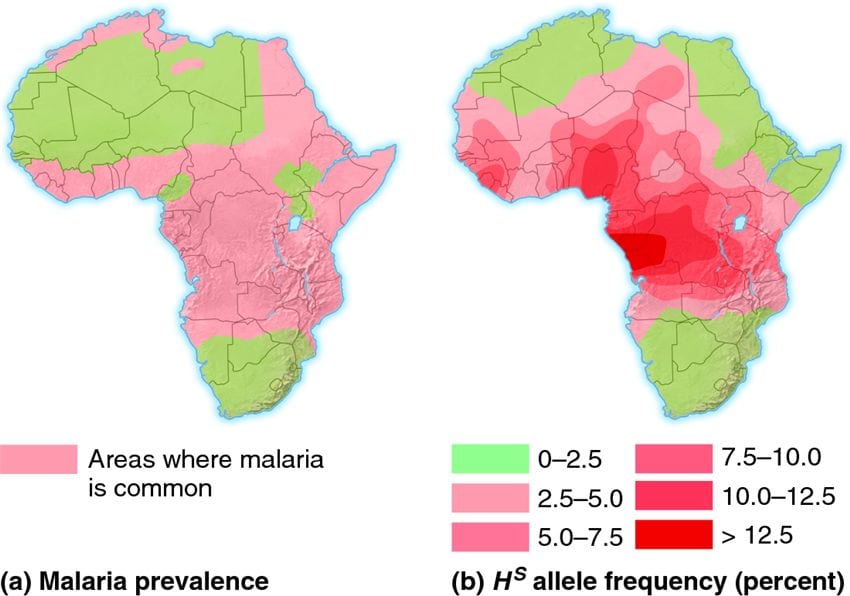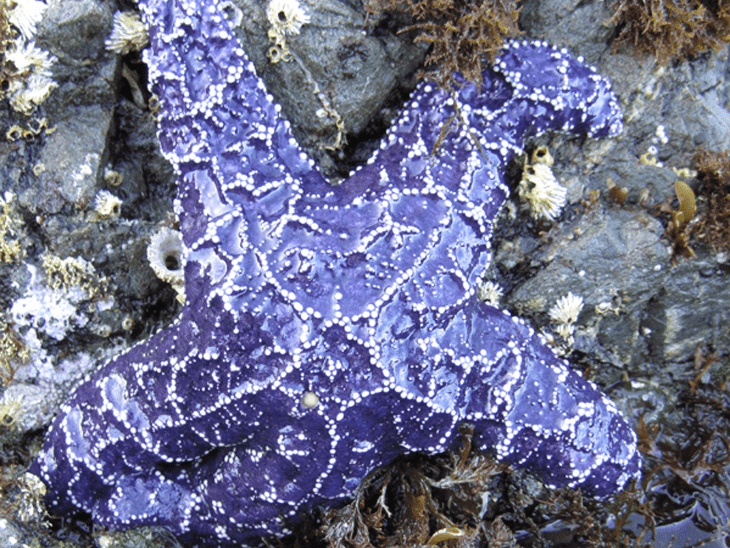Evolution runs on the principle of “survival of the fittestâ€- individuals that are better suited to their environment will be able to survive and reproduce more successfully. Following this logic, one would think that only the ‘good' (advantageous) genes are passed on through generations, and the ‘bad' (disadvantageous) genes are eventually eradicated. Thus, it is pretty surprising that some inherited diseases are so prevalent in the human population.
Let's take sickle cell anemia as an example. Oxygen is transported throughout our body by the blood, specifically by the red blood cells (RBCs). Normally, your RBCs are round, flat disks. However, in people afflicted by the disease sickle cell anemia, the RBCs are crescent-shaped. This means that RBCs break down very easily in the bloodstream, and oxygen transport is reduced. If a child is born with all of its RBCs in this crescent shape, they live a life of chronic pain, lowered immunity, and are susceptible to organ damage.
Sickle cell disease has its highest occurrence in Sub-Saharan Africa. In a surprising finding, it was observed that the regions where sickle cell anemia is most common coincide with regions where malaria is also most common (see image below). Malaria-causing parasites introduced into the blood by mosquitos use actin (another protein found in RBCs) to make bridges between cells and spread the malarial infection. However, if the RBCs are sickle-shaped, the parasites are not able to form these actin bridges. It appears that the “harmful†sickle cell disease is actually beneficial if one gets infected by malaria! This is a case of heterozygote advantage, and to understand it better, let's first look at how inheritance works.

For most of our traits, there are two gene variants that we can inherit from our parents. If we inherit the same variant from both parents, we are homozygous for that trait. And if we inherit two different variants from each parent, we are heterozygous for that trait.
Now let's take into consideration the gene that determines the shape of our RBCs. One of its variants is harmful and leads to the formation of sickle-shaped RBCs. The other variant of the gene gives normally shaped RBCs. Now if someone has two copies of the harmful gene variant (homozygous), then they have a really serious case of sickle cell anemia, and it will probably be the cause for their death. However, if you have only one copy of this harmful variant (the other copy being normal, thus you are heterozygous), then you'll have a “partial†sickle cell anemia. Some of your RBCs will be regular shaped, and some sickle shaped. You'll still have the symptoms of anemia, but it won't be fatal.
This is what “heterozygote advantage†really means. Individuals who are heterozygous for a certain trait will be more fit than their homozygous counterparts. And this heterozygous nature actually confers them an additional advantage in terms of survival. This allows them to pass on their genes to the future generations, and the harmful gene remains prevalent in the population. Sickle cell anemia is just one example: cystic fibrosis, the most common fatal genetic disorder in caucasians, can actually confer protection against cholera. Think about it like this: cholera causes constant loss of fluids through diarrhea, while cystic fibrosis causes the buildup of fluids in the body. Thus individuals with cystic fibrosis would actually be able to survive cholera!

Of course, humans aren't the only organisms with mechanisms like this one. In a study on starfish done by Dr. John Wares of the University of Georgia, a very interesting case of heterozygote advantage was observed. Earlier, a gene was discovered with one harmful version and one normal version. This harmful variant was so harmful that having two copies of it actually caused mortality at a very early age. However, starfish with only one copy of the mutated gene survived.
In their study, the researchers studied starfish affected with sea star wasting disease (SSWD), which has killed millions of seastars, the most recent epidemic having occurred in 2013. They noticed that among the survivors, a large percentage were heterozygous (had only one copy) for this particular mutated gene. Interestingly, there were more individuals in the surviving population that had one copy of the mutated gene that individuals with two normal copies! This indicated that the mutation that is fatal in homozygous individuals could actually protect against SSWD in heterozygous individuals!
Evolution leads to a species that is best suited to its environment. Sometimes this can mean retaining genes that are harmful to its survival (in the form of inherited diseases), so that it can be protected from harmful elements in its environment (i.e infectious diseases). The prevalence of inherited diseases over several generations seems like it goes against the principle of survival of the fittest, however, as seen from the examples above, natural selection can work in weird ways that may not be apparent at the start. In a way, heterozygote advantage seems like an immunity mechanism for a species, in the sense that it does not allow the species, as a whole, to get wiped out due to a single infectious disease.
About the Author
 Sunishka “Suni†Thakur is a junior majoring in Genetics. She is passionate about science education awareness and is involved with the Science Olympiad tournament held here on campus as a way of encouraging high school students to pursue science education. She aspires to go to graduate school and do research in the field of evolutionary biology. More from Sunishka Thakur! Sunishka “Suni†Thakur is a junior majoring in Genetics. She is passionate about science education awareness and is involved with the Science Olympiad tournament held here on campus as a way of encouraging high school students to pursue science education. She aspires to go to graduate school and do research in the field of evolutionary biology. More from Sunishka Thakur! |
About the Author
- athenssciencecafehttps://athensscienceobserver.com/author/athenssciencecafe/April 17, 2020
- athenssciencecafehttps://athensscienceobserver.com/author/athenssciencecafe/April 12, 2020
- athenssciencecafehttps://athensscienceobserver.com/author/athenssciencecafe/April 3, 2020
- athenssciencecafehttps://athensscienceobserver.com/author/athenssciencecafe/March 30, 2020







